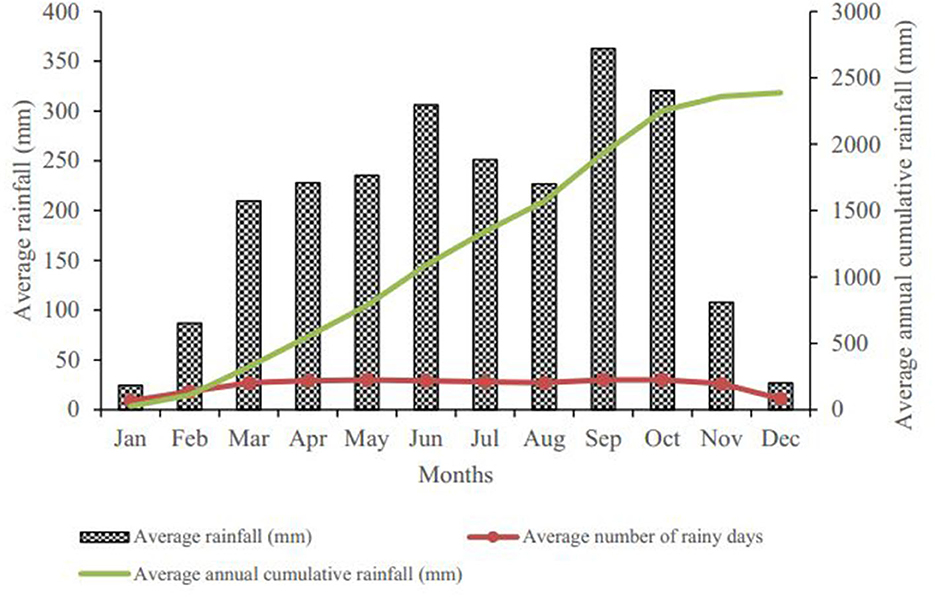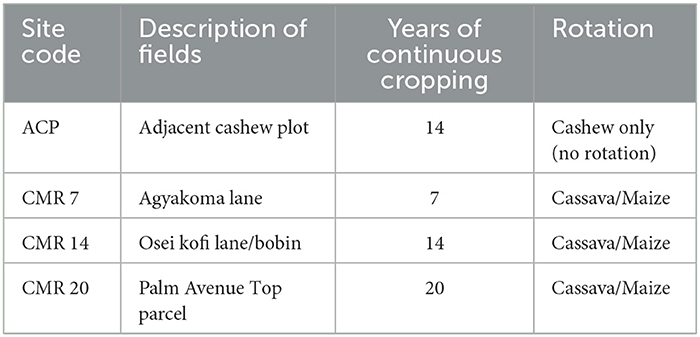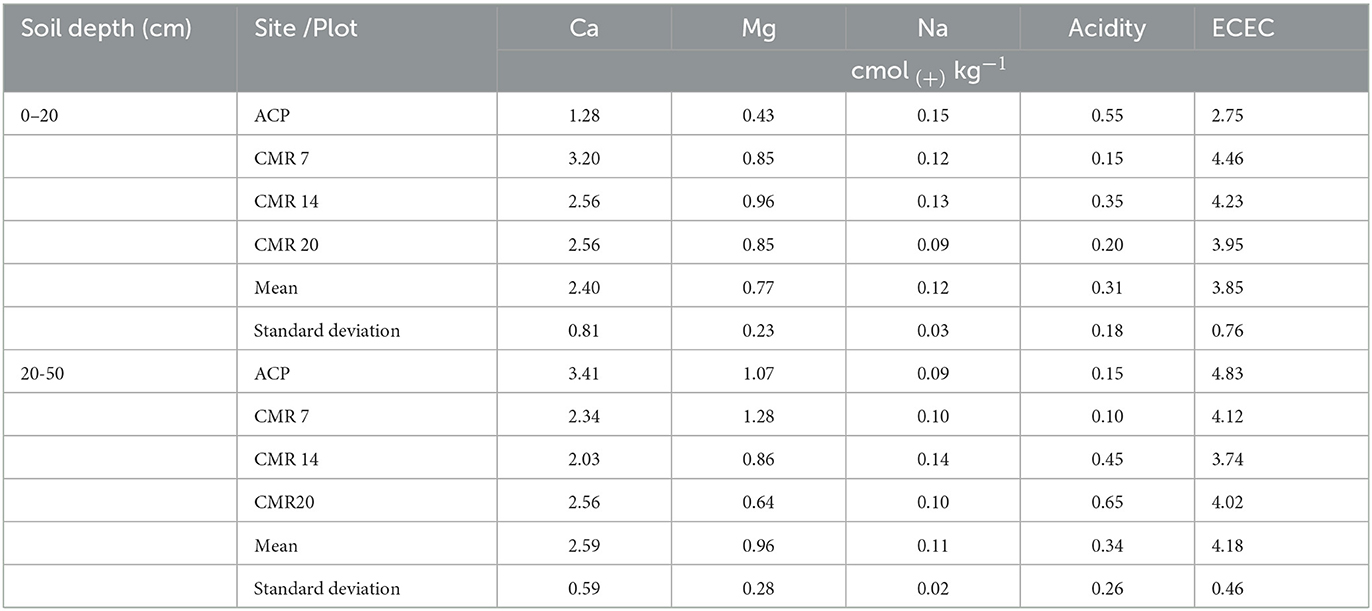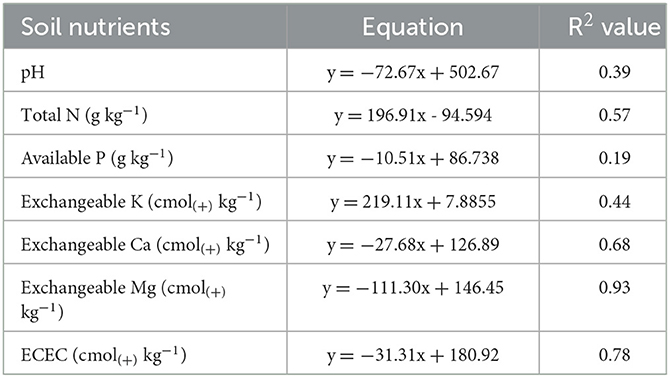Soil quality and fertility dynamics under a continuous cassava-maize rotation in the semi-deciduous forest agro-ecological zone of Ghana
- 1Department of Soil Resource Management, CSIR College of Science and Technology, Academy Post Office, Kwadaso, Kumasi, Ghana
- 2Soil Fertility and Plant Nutrition Division, CSIR-Soil Research Institute, Academy Post Office, Kwadaso, Kumasi, Ghana
- 3Faculty of Natural Sciences and Environmental Management, CSIR College of Science and Technology (CCST), Kumasi, Ghana
The practice of crop rotation is known to significantly influence soil nutrient dynamics, depending on the type of rotation and the crops involved. As such, a field study was conducted to find out the effect of continuous cassava-maize rotation, where mineral fertilizer was only applied to the maize crop, on soil nutrients dynamics and soil quality thereof under varying rotation periods. The study revealed that Soil Organic Matter (SOM) and levels of soil nutrients, such as total nitrogen, available phosphorus and exchangeable cations (potassium, calcium, magnesium, and sodium) significantly declined with rotation period. Long term maize–cassava rotation led to subsoil (20–50cm) acidification. Soil quality as measured by Carbon Management Index (CMI) on the different aged rotations decreased with age, with the longest rotation period giving the least quality. These results and observations imply that long term cassava-maize rotation reduced soil quality and the resilience of the cropping system for continuous sustainable crops production. A regression analysis of soil nutrients with CMI under the continuous cassava-maize rotation identified the crucial role of soil total N (r2 = 0.56) and exchangeable K (r2 = 0.44) in sustaining productive cassava-maize rotation system and improved soil quality within the semi-deciduous forest agro-ecological zone. It is thus, recommended that enhanced and targeted organic and inorganic fertilization regime could be deployed on the cassava-maize rotation system to improve the inherently low levels of nutrients and increase crop yields.
1. Introduction
Cassava (Manihot esculenta Crantz) is a major staple food crop for over 800 million people in sub-Saharan Africa providing their calorie needs (Burns et al., 2010). It is the third most important source of calories next to rice and maize in tropical countries (Luar et al., 2018). Cassava also has the potential for use as an industrial raw material in the starch, alcohol and animal feed industries. The crop is regarded as a hardy crop, growing on marginal lands with little or no inputs, and it is usually planted as the last crop in any crop rotation cycle (Salami and Sangoyomi, 2013). Cassava is known to produce appreciable root yields in depleted soils where other crops would fail even though the crop removes substantial amounts of nutrients with the roots at harvest (Ayoola and Makinde, 2007). Despite the aforementioned, cassava production is constrained by several factors including low soil fertility, drought, and poor adoption of good agronomic practices leading to low root yields on croplands (El Sharkawy, 2007).
In Ghana, cassava is the lead starchy staple crop planted to over 900,000 hectares with an annual production of over 17.2 million metric tons (MT). Current average cassava yield is 18.73 MT ha−1 which is only 42 % of the potential yield of 45–50 MT ha−1 (MoFA-SRID, 2016). Such low root yields are attributed mainly to low soil fertility and poor land management.
Even though cassava is known to grow well on most soils, adequately well-drained soils that can retain enough moisture are quite ideal. Cassava, therefore, grows best on light to medium textured and well drained soils. The crop can thrive within a pH range of 4.5–7.5 but a range of 5.5–6.5 is more ideal. Cassava is a heavy feeder and therefore its nutrient removal from the soil for optimum yields is relatively high when compared to other root crops. Even though the crop is known to adapt to medium levels of soil N and P, it requires larger quantities of K, and more so when grown at a particular location over a longer period. On average, cassava extracts 4.9 kg N, 1.1 kg P and 5.8 kg K per ton of tuber harvested (Howeler, 1981).
Most often, the crop does not respond to mineral fertilizer applications when a virgin land or relatively fertile soils are cultivated. However, after a few years of continuous cultivation on the same piece of land, substantial P and K deficits are observed, particularly where soil erosion and leaching are quite high. Soil K is often the significant source of variation in yield after a few years cultivation in the absence of adequate and balanced fertilizer application. The crop also requires adequate levels of nutrients such as Ca, Mg, S and Zn for optimum root yields (Howeler, 1991).
This study was undertaken on the fields of JOSMA Agro-industries, a private and major cassava growing and processing company in the Ashanti region, located within the semi-deciduous forest agro-ecological zone of Ghana. JOSMA Agro-industries focuses on producing and processing cassava as their main activity. Over the years, a cassava-maize rotation system has been adopted on their croplands with mineral fertilizers applied to only the maize crop in the rotation. The purpose of applying mineral fertilizer is to ensure sustainable maize production, with the hope that the cassava crop, which follows the maize in the rotation, will benefit from the residual effect of the mineral fertilizer.
The present study was conducted to investigate the long-term effect of cassava - maize rotation on soil fertility status and soil quality of a Gleyic Arenosol in the semi deciduous forest zone of Ghana. Specifically, the study sought to (i) determine the current soil fertility status of the cassava-maize rotation, based on the different durations of cultivation, (ii) assess soil quality status (using Carbon Management Index as an indicator of soil quality) (iii) identify the most limiting nutrients and soil conditions affected by continuous cassava-maize rotation, and (iv) identify the most important soil properties that were influenced under the different crop-rotation systems, using principal component analysis.
2. Materials and methods
2.1. Characteristics of the study site
This study was undertaken on the fields of JOSMA Agro-industries, a private and major cassava growing and processing company in Ghana. JOSMA Agro-industries croplands are located at Woraso, near Ashanti Mampong in the Ashanti region, which lies between latitude 7o 07' and 7o12'N and longitude 1o 23' W, in the semi deciduous forest zone of Ghana. Annual temperatures are relatively high with a monthly mean of about 25.8°C.
The study area experiences equatorial climatic regime with two distinct rainy seasons with a mean annual rainfall of about 2390 mm in 294 rainy days (Figure 1). The major rainy season runs from April to July, during which over 75% of the annual rainfall may be received. The minor season occurs between September and November, followed by a long dry season from late November to early April (Figure 1).
The soils of the various parcels of croplands as described by Adu and Mensah Ansah (1995) are soils that have been developed over coarse-grained Voltaian Sandstone and classified as Gleyic Arenosol. In the natural state, the top soil is known to consist of 8–30 cm of dark brown, humus, loamy sand which grades downwards into a less humus dark brown to loamy sand. However, several years of cassava-maize rotation under regular deep plowing has transformed the top soils into brown loamy sands with no visible signs of dark brown color. Below the top soil at about 20 cm is yellowish red to reddish yellow sandy clay loam which is underlain by ironstone concretions from 60 to 80 cm depth. Even though the soils have been described as suitable for the production of cassava and maize, it has been suggested that higher doses of N, P, and K fertilization are needed for continuous and sustainable crop production (Adu and Mensah Ansah, 1995).
2.2. Crop management
Crop production activities were arranged in a Cassava - Maize rotation on all parcels of croplands. The recommended mineral fertilizer rate of 60:40:40 kg ha−1 of N-P2O5-K2O was applied solely to the maize crop in the cassava-maize rotation. No organic or mineral fertilizers were consciously applied to the cassava crop.
Management staff of the farm were interviewed to assess the cropping systems that were adopted and the ages of the different parcels of croplands. The general description of the different parcels of cassava-maize plots are presented in Table 1. The lands were normally deeply-plowed using four-wheel tractors during land preparation before maize cultivation and later cassava was planted in the rotation. Mineral fertilizers, mainly NPK 15:15:15 and NPK 23:10:0, depending on their availability on the market, were applied to only the maize crop at a rate of 60-40-40 N-P2O5-K2O kg ha−1.
2.3. Soil sampling
Composite soil samples were collected at 0–20 cm and 20–50 cm soil depth from the different fields of cassava-maize rotation croplands for routine physico-chemical analysis using a soil auger. Soil sampling sites were selected in a manner so as to minimize soil variability from six spots on each field. In addition, composite soil samples were taken from an adjacent 14-year-old cashew plantation (Osei Kofi Lane) near the site for comparison. Soil samples were labeled and conveyed to the CSIR-Soil Research Institute laboratory for analysis.
2.4. Laboratory analysis
Soil samples were air-dried, crushed and sieved through a 2 mm sieve before analysis. Soil pH was measured in 1:2.5 soil-water ratio using a glass electrode (H19017 Microprocessor) pH-meter (ASTM, 1995). Soil organic carbon was determined by the modified dichromate oxidation method of Walkley-Black as described by Nelson and Sommers (1982). Total nitrogen was determined by the Kjeldahl digestion and distillation procedure as described by Bremner and Mulveney (1982). Available Phosphorus was measured by the Bray 1 method as described by Bray and Kurtz (1945) while exchangeable bases (K, Ca, Mg, Na) were extracted in 1.0 M ammonium acetate (NH4OAc) extract as described by Thomas (1982). Exchangeable calcium and magnesium were determined by EthylenediamineTetracetic Acid (EDTA) titration, whiles exchangeable potassium and sodium were determined by flame photometry. Exchangeable acidity was determined in 1.0 M KCl extract as described by Page et al. (1982). Effective cation exchange capacity was calculated as the sum of exchangeable bases (Ca2+, Mg2+, K+, and Na+) and exchangeable acidity (Al3+ + H+). Particle size distribution was determined by the Bouyoucos hydrometer method as modified by Day (1965).
2.5. SQ determination
Soil quality was determined using Carbon Management Index (CMI) method, an assessment model that shows how a particular land use affects the soil quality relative to a reference land use soil (Blair et al., 1995). This technique is based on the premise that soil organic matter changes are gradual such that small changes are difficult to detect by conventional methods. It simulates the oxidative action of soil microbes by using 333 mM KMnO4 to breakdown the readily decomposable organic compound known as labile carbon (Blair et al., 1995). The difference between the total organic carbon (Walkley–Black C) and the labile carbon gives the non-labile carbon which is that component of soil organic carbon that is likely to remain in the soil for relatively long periods. The resulting three soil C pools can therefore be used to initialize C cycling models (Blair et al., 1996).
Carbon Management Index was therefore determined as follows:
where CPI is the Carbon Pool Index, and LI is the Lability Index of the soil under a particular land use (crop-rotation system),
2.6. Statistical analysis
The summary statistics of data collected from this study were determined using the Statistix 10 Windows statistical package. In addition to this, regression coefficients of studied soil nutrients with CMI on the different crop-rotation systems was computed. Also, an Eigen-vector based multivariate analysis, Principal Component Analysis (PCA), was used to extract the maximum variance in the data and identify the most important soil properties (variables) that were positively or negatively influenced by the different crop-rotation systems during the study period. Principal components were identified as the variables with Eigen value >1 and had a cumulative percentage variance of ≥80%. The with absolute loadings of ≥0.50 were identified as the significant variables contributing to each principal component.
3. Results and discussion
3.1. Soil texture
The soils are naturally deep with no gravels and concretions encountered within the 0–50 cm soil depth. The top soils (0–20cm) were observed to be sandy or sandy loam with an average particle size distribution of 880 ± 32.66 g kg−1 sand, 40 ± 16.33 g kg−1 silt and 80 ± 36.51 g kg−1 clay (Table 2). These soil textures are noted to have lower soil moisture and nutrient retention capacities for sustainable cassava production under such soil conditions, nutrient losses are expected to be very high particularly through leaching and erosion. These losses are enhanced by the effect of annual deep plowing using heavy equipment such as tractors. In addition, the sub-soils (20–50cm) of some plots have relatively higher levels of clay (160 – 220 ± 34.16 g kg−1) (Table 2), which otherwise would have occurred below the 0–50 cm soil layer in the natural state (Adu and Mensah Ansah, 1995). This could limit root penetration and expansion under dry conditions and hence reduce cassava root yield. Continuous cassava cultivation has been reported to cause more soil loss through erosion due to regular deep plowing, wider spacing and slow initial crop growth thereby bringing the deeper non-desirable soil conditions, such as higher clay content, closer to the surface horizon. Such plowing could also possibly result in surface compaction for areas from the use of heavy machinery (Howeler, 2017a).
3.2. Soil fertility dynamics under continuous cassava-maize rotation
3.2.1. Soil pH
The pH of the topsoil (0–20 cm) ranged from 5.8 to 6.4 with a mean of 6.1 ± 0.23 while subsoil (20–50 cm) pH ranged from 5.7 to 6.4 with a mean of 6.1 ± 0.37 (Table 3). These pH levels are rated as moderately to slightly acidic (Loganathan, 1987) or medium (Howeler, 2017b) and are optimum for sustainable cassava production in the semi-deciduous forest agro-ecological zone. Topsoil pH was higher for all the different ages of cassava-maize rotation lands (CMR 7, CMR 14, and CMR 20) than the non-rotation adjacent cashew plot (ACP), though they were all moderately acidic. This is an indication that the disturbances of the topsoil associated with the continuous cassava-maize cropping particularly plowing and mineral fertilizer application helped to raise soil pH. However, sub-soil pH declined steadily with age (CMR 7 > CMR 14 > CMR 20), indicating possible increased acidity with age under continuous cassava-maize rotations. Soil pH reduction under continuous cropping with inorganic fertilizer application and constant deep plowing could be attributed to soil reaction associated with inorganic fertilizer use (based on type of fertilizer), accelerated soil erosion due to constant plowing and reduced soil organic matter accumulation on croplands as earlier observed by FAO and IFAD (2001).
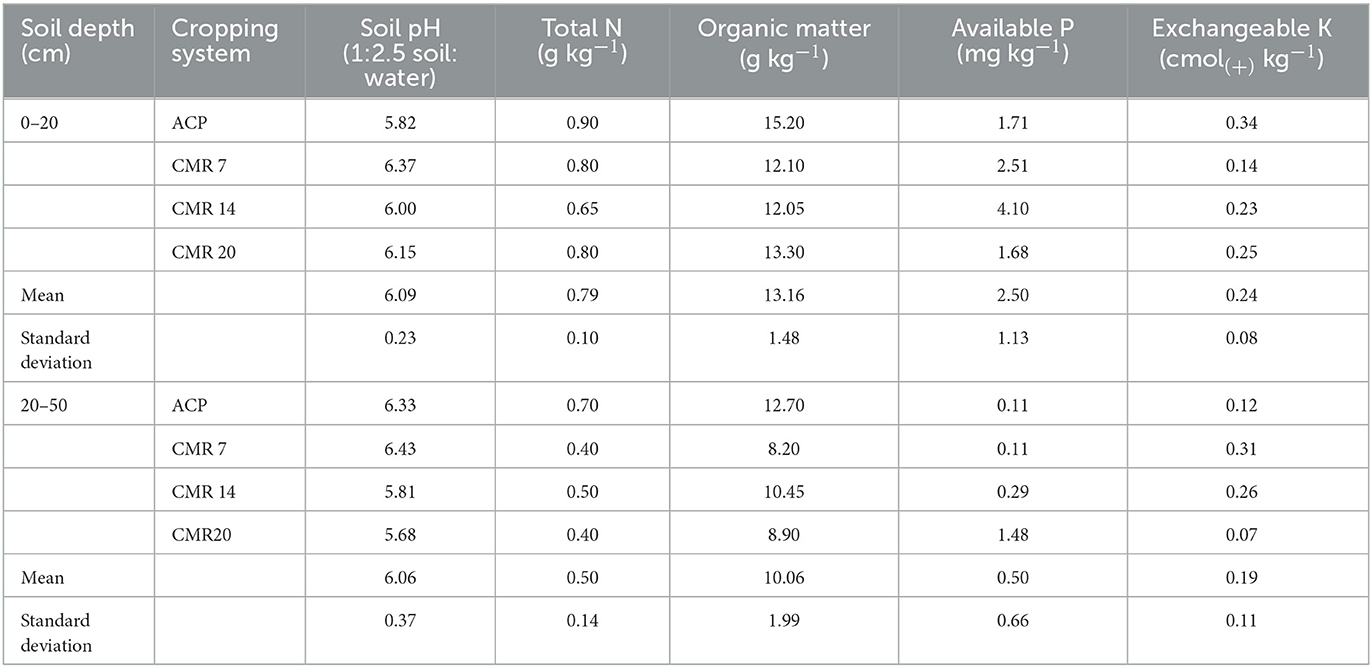
Table 3. Soil nutrient dynamics within 0–20 cm and 20–50 cm soil depths under various cropping systems.
3.2.2. Soil total nitrogen
Soil total N levels ranged from 0.7 to 0.9 g kg−1 for the topsoil (0–20 cm) with a mean value of 0.8 ± 0.10 g kg−1 and from 0.4 to 0.7 g kg−1 for the subsoil (20–50 cm) with a mean of 0.5 ± 0.14 g kg−1 (Table 3). Total N levels for the topsoil and subsoil were <1.0 g kg−1 and rated as low for sustainable maize and cassava production. The higher N level of 0.9 g kg−1 under the adjacent cashew plot (ACP) indicates that continuous cassava-maize cropping has resulted in a reduction of soil total N levels indicative of nutrient mining as mineral fertilizer additions may be either inadequate or unbalanced. Soil total N within the entire 0–50 cm soil depth varied with age of continuous cassava-maize rotation in the order ACP > CMR 7 > CMR 14 > CMR 20, indicating that continuous cassava-maize rotation led to reduced soil total Nitrogen with time, as all these were lower than the level recorded under the Adjacent Cashew Plot. Recorded levels of soil total N were far lower than the 1.2 g kg−1 reported by Adu and Mensah Ansah (1995) on a similar soil type under relatively stable natural vegetation. Thus, confirming that continuous cropping of any nature, regardless of the rotation type and age, leads to reduced soil total N.
3.2.3. Soil organic matter
Soil organic matter levels on all cassava-maize rotation fields were low for sustainable cassava production when compared to the classification of Howeler (2017b). Topsoil (0–20cm) levels ranged from 12.05 to 13.3 g kg−1 while subsoil (20–50cm) levels ranged from 8.2 to 12.7 g kg−1 (Table 3). Mean levels were 13.2 ± 1.48 g kg−1 and 10.1 ± 1.99 g kg−1 for the topsoil and subsoil, respectively. Soil organic matter levels on the cassava- maize rotation fields were all lower than the level under the ACP field which recorded levels of 15.2 and 12.7 g kg−1 for the topsoil and sub soil, respectively. This is an indication that continuous cassava-maize rotation resulted in SOM depletion, which could be due to a higher rate of decomposition (mineralization), and lower rate of accumulation (continuous removal of farm biomass) and erosion. Observed levels of soil organic matter for 0–20 cm soil depth was lower than the 18.0 g kg−1 reported by Adu and Mensah Ansah (1995) on a similar soil under relatively stable natural vegetative conditions. This confirms that continuous cassava-maize rotation leads to SOM depletion with possible adverse consequences on cropland productivity and soil carbon sequestration.
3.2.4. Soil available phosphorus
Soil available P (Bray 1) levels ranged from 1.68 to 4.1 mg kg−1 within the top soil and from 0.11 to 1.48 mg kg−1 within the sub soil (Table 3). Mean values were 2.50 ± 1.13 mg kg−1 and 0.5 ± 0.66 mg kg−1 for the topsoil and subsoil, respectively (Table 3). These levels are <10 mg kg−1 the optimum available P levels (Loganathan, 1987) and rated as very low for sustainable and continuous crop production in the ecological zone. Topsoil available P levels increased gradually with time with the highest recorded under CMR 14, among all the other studied crop-rotation systems (including the ACP) indicating that cassava-maize rotation could have improved topsoil available P over time. The improvement in available P could, however, not be sustained beyond 14 years under the adopted land management regime. There was, however, a gradual improvement in available soil P levels with age of rotation within the subsoil (20–50 cm) with the oldest rotation period (20 years) recording the highest improvement of 1.48 mg kg−1. This could be attributed to lower cassava P off-take and the residual effect of the continuous application of inorganic fertilizer to the maize crop. There is also the possibility of a highly effective symbiosis between the cassava and naturally occurring mycorrhizal fungi in the soil as reported by Howeler (2017b). The author explained that due to its coarse root system, cassava is highly dependent on Vesicular Arbuscular Mycorrhiza (VAM) for enhanced P uptake even under limiting soil P reserves to produce reasonable yield. This indicates that long term continuous cassava-maize production with some levels of mineral fertilizer application to the maize crop in the rotation, has the potential to enhance soil available P.
3.2.5. Soil exchangeable potassium
Mean exchangeable K levels for the topsoil (0–20cm) was 0.24 ± 0.08 cmol(+) kg−1 ranging from 0.14 to 0.25 cmol(+) kg−1 under the cassava-maize rotation plots (Table 3). These levels are lower than the 0.34 cmol(+) kg−1 recorded under the ACP plot within the 0–20 cm soil depth. This is an indication that continuous cassava-maize rotation decreased exchangeable K with time, even with the amounts of mineral fertilizer applied to the maize crop in the rotation. Mean subsoil exchangeable K was also 0.19 ± 0.11 cmol(+) kg−1 ranging from 0.07 to 0.31 cmol(+) kg−1 (Table 3). However, there was a gradual increase in soil exchangeable K with time within the subsoil for medium duration (7–14 years) rotations. Subsoil exchangeable K level was in the order: CMR7 > CMR 14 > CMR 20 indicating that continuous cassava – maize rotation reduced subsoil exchangeable K with time. This has the potential to lead to soil degradation if the current soil management regime is maintained. Even though the recorded mean soil exchangeable K levels are rated as medium for continuous cassava production (Howeler, 2017a), appropriate steps must be taken to improve these levels through fertilizer additions (organic/inorganic) to sustain higher levels of root yield such as cassava.
3.2.6. Other soil exchangeable cations
There were generally low levels of the other exchangeable cations (Ca, Mg, Na) across all cassava-maize rotation fields, leading to low effective cation exchange capacity (ECEC) levels (Table 4). Exchangeable Ca levels ranging from 1.28 to 3.41 cmol(+) kg−1, was rated as low. According to Loganathan (1987), soils with exchangeable Ca levels <5.0 cmol(+) kg−1 cannot support effective crop growth and will require fertilizer additions to improve levels. Similarly, exchangeable Mg levels ranged from 0.43 to 1.28 cmol(+) kg−1 which are also rated as low according to Loganathan (1987), as levels fall below the minimum 2.0 cmol(+) kg−1 required for effective root crop growth and optimum yields. Only exchangeable Na ranging from 0.09 – 1.15 cmol(+) kg−1 was rated as high according to Loganathan (1987) across all fields and at the various soil depths (Table 4). Loganathan (1987) further suggests that soils with ECEC levels <10 cmol(+) kg−1 cannot support or sustain cassava production unless adequate mineral fertilizer additions are made.
These results are also in agreement with the earlier observations of Sat and Deturck (1998) who reported that long-term cassava cultivation caused the most serious reduction in the ECEC, exchangeable K and Mg status compared with the long-term effect of forest, para rubber, cashew or sugarcane on the soil. In this study, continuous cassava-maize rotation had similar effect on ECEC, K and Mg compared to the adjacent cashew plot.
3.3. Soil quality dynamics
As shown in Table 5, the carbon management index (CMI), which was used as an indicator of soil quality, was highest in CMR7 and lowest in CMR20, as against the ACP (the reference land use type). CMI on the different aged cassava-maize rotation plots decreased greatly with the age, indicating that long term cassava-maize rotation reduced soil quality. This resulted in a sharper reduction of soil labile carbon (LC) fraction on the rotation plots with age, compared to the less severe reduction of TOC levels on the same plots (Table 4), indicating that continuous cassava-maize rotation led to more mineralization of soil organic matter compared to the adjacent cashew plot (ACP).
A similar observation was reported by Blair et al. (1996) that showed land use systems with high level disturbances such as regular plowing, accelerated TOC decomposition and hence LC reduction. In this study, continuous plowing, wider spacing of cassava, slow early cassava growth and associated inadequate mineral fertilizer use could have enhanced erosion and contributed to the reduction in both TOC and LC levels on the cassava-maize rotation plots and therefore affected the CMI, and hence soil quality. These observations are in line with the findings of Sainepo et al. (2018), who working on different land use patterns in Kenya, reported similar values of CMI on different land use types and confirmed that CMI could be used as a reliable indicator for soil degradation or improvement in response to land use and land cover changes.
3.4. Regression analysis among the soil nutrients with CMI
A regression analysis of some major soil nutrients and CMI revealed that pH, available P, exchangeable Ca, Mg and ECEC were negatively influenced by CMI whilst total N and exchangeable K were positively affected (Table 6). Total N and exchangeable K positively accounted for about 56.5 and 44.3%, respectively of the total variability in soil quality as measured by CMI. In addition, for every one unit increase of soil Total N, the CMI increases by 196.9 units, whilst for every one unit increase of exchangeable K, the CMI increases by 219.1 units. This indicates that any soil management practice that lead to improvements or increases in soil total N and exchangeable K levels, can also lead to a better or improved soil quality and resilience for sustainable and continuous cassava-maize rotation.
These results are in line with the findings of Zanatta et al. (2019) who indicated that N fertilization was able to contribute about 8–33% improvement in soil quality better than no fertilizer under similar soil condition in Brazil. Furthermore, these results also corroborate with the findings of Adjei-Nsiah et al. (2007) who identified N and K as playing major roles in sustaining crops yield under cassava-maize rotation in Ghana.
3.5. Principal component analysis for the most important soil properties influenced by the different crop-rotation systems in this study
Results from the PCA of the soil properties, resulting Eigen values, individual percentage and cumulative variances in the topsoil (0–20 cm) and subsoil (20–50 cm) are presented in Tables 7, 8. For the topsoil, three principal components (PC1, PC2, PC3) were found to cumulatively explain approximately 99.99% of the variation in the soil properties among the crop rotation years. The soil properties which largely contributed to the variation in the topsoil were available P and exchangeable Na with Eigen vector scores of 0.59 and 0.73, respectively, as presented in Table 7.
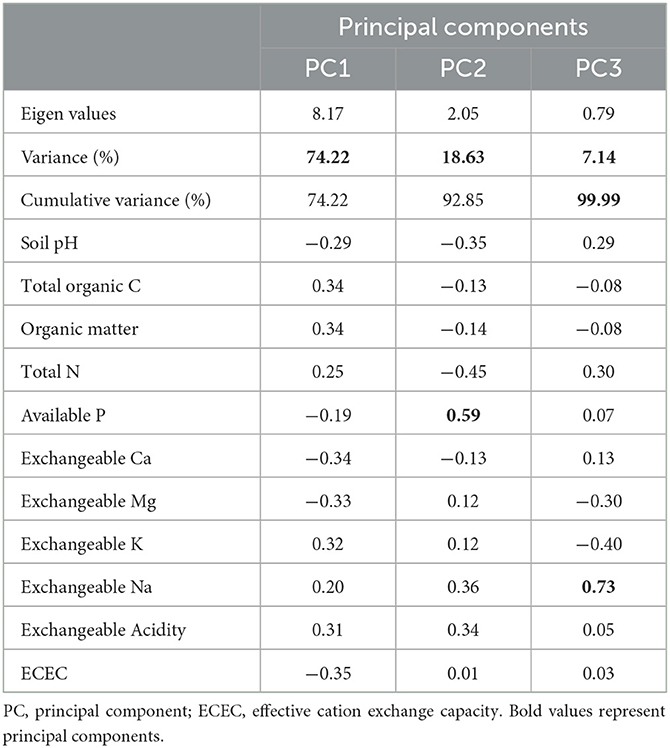
Table 7. Principal component analysis for soil properties influenced by the different crop-rotation systems in the top soil (0–20 cm).
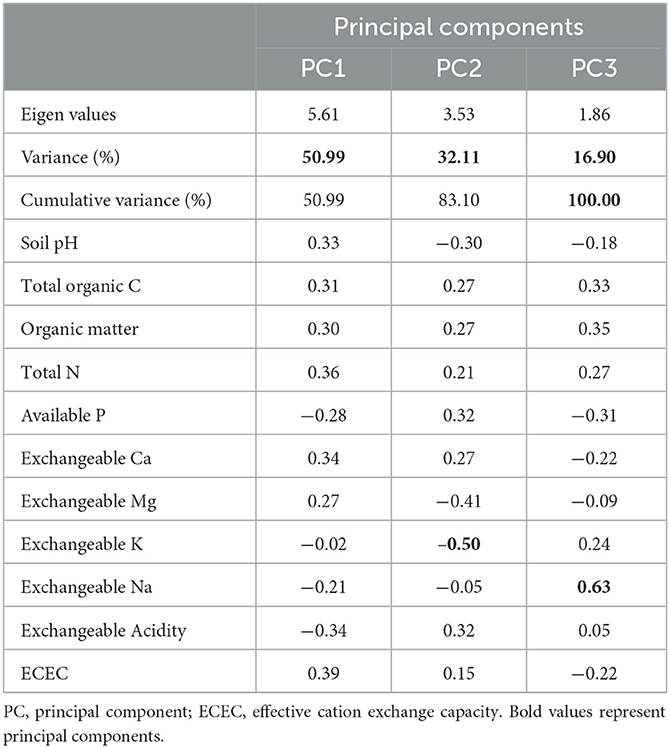
Table 8. Principal Component Analysis for soil properties influenced by the different crop-rotation systems in the sub-soil (20–50 cm).
Similarly, for the subsoil, three principal components were also found to cumulatively explain 100% of the variation in soil properties among the crop rotation years. These variations were largely contributed by exchangeable K and Na with absolute Eigen vector scores of 0.50 and 0.63, respectively (Table 8).
4. Conclusion
Long term cassava-maize rotations with inorganic fertilizer applied to only the maize crop leads to subsoil acidification. Such rotations also lead to significant reductions in SOM levels and soil nutrients such as total N, available P and the exchangeable bases (Ca, Mg, Na). As length of rotation period increased, levels of these nutrients continued to fall leading to nutrient mining and ultimately soil degradation. Even though levels of exchangeable K also decreased over the period with time, such reduction were quite minimal.
Soil Quality as measured by CMI declined with age under the continuous cassava-maize rotation indicating that the cropland management practices adopted by the landowners were not sustainable and lowered the resilience of the cropping system. As such, current nutrient management practices do not allow for nutrient build up. The use of compound fertilizer NPK: 23-10-0, that was sometimes used to fertilize the maize is neither good for maize nor cassava production because of the unbalanced nature of the nutrients and more importantly the very low levels of both P and K.
5. Recommendations
It is recommended that enhanced and targeted organic and inorganic fertilization regime could be deployed on the cropping system to improve the inherently low levels of exchangeable bases and increase crop yields. Soil management practices that improve SOM levels and enhance water and nutrient retention should be adopted. These may include the addition of farmyard manure, poultry droppings and legume rotations. The use of heavy farm machinery and deep plowing should be discouraged. Instead, light machinery supported by shallow plowing across the slope (direction of water flow) will reduce rapid erosion and minimize further degradation of the soil.
In addition, the cassava crop should be consciously fertilized using recommended mineral fertilizers. Maize should be fertilized using NPK 15-20-20 + Zn as recommended by the CSIR-Soil Research Institute. Good Agronomic Practices (GAP) that are recommended for Cassava and maize production must also be adopted.
Data availability statement
The raw data supporting the conclusions of this article will be made available by the authors, without undue reservation.
Author contributions
EOA, BEA, and MMB conceived the research, edited, revised, and made significant contributions. EOA and MMB planned the work. EOA, MMB, NB, and KA set up the experiment. EOA, BEA, NB, and KA collected and analyzed the data. EOA drafted the manuscript. All authors contributed to the article and approved the submitted version.
Funding
The research leading to these results received partial funding from the JOSMA Agro-Industries, Ghana.
Acknowledgments
The authors acknowledge the contributions of Management of JOSMA Agro-Industries and Staff of the Laboratory Analytical Services Division of the Soil Research Institute toward this study and subsequent preparation of this manuscript.
Conflict of interest
The authors declare that the research was conducted in the absence of any commercial or financial relationships that could be construed as a potential conflict of interest.
Publisher's note
All claims expressed in this article are solely those of the authors and do not necessarily represent those of their affiliated organizations, or those of the publisher, the editors and the reviewers. Any product that may be evaluated in this article, or claim that may be made by its manufacturer, is not guaranteed or endorsed by the publisher.
References
Adjei-Nsiah, S., Kuyper, T. W., Leeuwis, C. M. K., and Giller, K. E. (2007). Evaluating sustainable and profitable cropping sequences with cassava and four legume crops: effects on soil fertility and maize yields in the forest/savannah transitional agro-ecological zone of Ghana. Field Crops Res. 103, 87–97. doi: 10.1016/j.fcr.2007.05.001
Adu, S. V., and Mensah Ansah, J. A. (1995). Soils of the Afram Basin, Ashanti and Eastern regions, Ghana. Accra: Soil Research Institute.
ASTM (1995). Annual Book of ASTM Standards. Designation D4972-95a: Standard Test Method of pH of Soils. West Conshohocken, PA: ASTM.
Ayoola, O. T., and Makinde, E. A. (2007). Fertilizer treatment effects on performance of cassava under two planting patterns in a cassava-based cropping system in South West Nigeria. Res. J. Agric. Biol. Sci. 3, 13–20.
Blair, G. J., Conteh, A., Blair, N., Lefroy, R. D. B., Whitbread, A., Daniel, H., et al. (1996). “The use of the carbon management index and relationships between KMnO4 Oxidizable C and Soil Aggregate Stability,” in Proceedings of the Soils and Agronomy Coordination Meeting 3 - 4 December, 1996. Richard Williams Conference Room Australian Cotton Research Institute, Narrabri NSW.
Blair, G. J., Lefroy, R. D., and Lisle, L. (1995). Soil carbon fractions based on their degree of oxidation, and the development of a carbon management index for agricultural systems. Crop Pasture Sci. 46, 1459–1466. doi: 10.1071/AR9951459
Bray, R. T., and Kurtz, L. T. (1945). Determination of total, organic and available forms of phosphorus n soil. Soil Science 599, 39–45. doi: 10.1097/00010694-194501000-00006
Bremner, J. M., and Mulveney, V. A. (1982). Steam distillation methods for ammonium, nitrate and nitrite. Analytica Chimica Acta 32, 485–495. doi: 10.1016/S0003-2670(00)88973-4
Burns, A., Gleadow, R., Cliff, J., Zacarias, A., and Cavagnaro, T. (2010). Cassava the drought, war and famine crop in a changing world. Sustainability 2, 3572–3607. doi: 10.3390/su2113572
Day, P. R. (1965). “Fractionation and particle size analysis,” in Methods of soil analysis, ed C. A. Black (Madison Winconsin: American society of Agronomy and soil science society of America), 545–567.
El Sharkawy, M. A. (2007). Physiological characteristics of cassava tolerance to prolong drought in the tropics: implications for breeding cultivars adapted to seasonally dry and semi-arid environments. Braz. J. Plant Physiol. 19, 257–286. doi: 10.1590/S1677-04202007000400003
FAO and IFAD (2001). “Strategic environmental assessment: An assessment of the impact of cassava production and processing on the environment and biodiversity,” in Proceedings of the Validation Forum on the Global Cassava Development Strategy. Rome: FAO.
Howeler, R. H. (1981). Mineral nutrition and fertilization of cassava. Series 09EC-4. Cali, Columbia CIAT.
Howeler, R. H. (1991). Long term effect of cassava cultivation on soil productivity. Field Crops Res. 26, 1–18. doi: 10.1016/0378-4290ETAL90053-X
Howeler, R. H. (2017a). “Does cassava cultivation degrade or improve the soil. A new future for cassava in Asia: its use as food, feed and fuel to benefit the poor,” in Proceedings 8th Regional Workshop held in Vientiane, Laos.
Howeler, R. H. (2017b). Cassava cultivation and soil productivity in achieving sustainable cultivation of cassava. Cultiv. Tech. 1, 285–300. doi: 10.19103/AS.2016.0014.25
Luar, L., Pampolino, M., Ocampo, A., Valdez, A., Cordora, D. F., and Oberthür, T. (2018). Cassava response to fertilizer application. IPNI Project PHL-5. Better Crops 102, 2. doi: 10.24047/BC102211
Ministry of Food and Agriculture (MoFA) Statistics Research and Information Directorate (SRID).. (2016). Agriculture in Ghana, Facts and Figures. Accra: Ministry of Food and Agriculture (MoFA) Statistics. p. 113.
Nelson, D. W., and Sommers, L. W. (1982). “Total carbon, organic carbon and organic matter,” in Methods of soil analysis, Part 2 second edition. Chemical and microbiological properties, eds A. L. Page, R. H. Miller, D. R. Keeney (Madison Winconsin: American Society of Agronomy and Soil Science Society of America).
Page, A. L., Miller, R. H., and Keeney, D. R. (1982). Methods of Soil Analysis. Part 2. Chemical and Microbiological Properties. Madison Winconsin: American Society of Agronomy and Soil Science Society of America.
Sainepo, B. M., Gachene, C. K., and Karuma, A. (2018). Assessment of soil organic carbon fractions and carbon management index under different land use types in Olesharo Catchment, Narok County, Kenya. Carbon Bal. Manage. 13, 1–19. doi: 10.1186/s13021-018-0091-7
Salami, B. T., and Sangoyomi, T. E. (2013). Soil fertility status of cassava fields in south western Nigeria. J. Exp. Agric. Int.. 3, 152–164. doi: 10.9734/AJEA/2013/2088
Sat, C. D., and Deturck, P. (1998). “Cassavas soils and nutrient management in South Vietnam,” in Cassava Breeding, Agronomy and Farmer Participatory Research in Asia. Proceedings 5th Regional Workshop, Danzhou, Hainan, China, 257–267.
Thomas, G. W. (1982). “Exchangeable cations,” in Methods of Soil Analysis. Part 2. Agron. Monograph 9, eds A. L. Page, R. H. Miller, D. R. Keeney (Madison Winconsin: American Society of Agronomy and Soil Science Society of America), 159–165.
Keywords: cassava, maize, semi-deciduous forest, soil fertility, soil quality, sustainability
Citation: Adjei EO, Ayamba BE, Buri MM, Biney N and Appiah K (2023) Soil quality and fertility dynamics under a continuous cassava-maize rotation in the semi-deciduous forest agro-ecological zone of Ghana. Front. Sustain. Food Syst. 7:1095207. doi: 10.3389/fsufs.2023.1095207
Received: 10 November 2022; Accepted: 31 January 2023;
Published: 01 March 2023.
Edited by:
Folorunso Mathew Akinseye, International Crops Research Institute for the Semi-Arid Tropics (ICRISAT), KenyaReviewed by:
Rakesh S., National Academy of Agricultural Research Management (ICAR), IndiaVesna Radovanović, University of Belgrade, Serbia
Copyright © 2023 Adjei, Ayamba, Buri, Biney and Appiah. This is an open-access article distributed under the terms of the Creative Commons Attribution License (CC BY). The use, distribution or reproduction in other forums is permitted, provided the original author(s) and the copyright owner(s) are credited and that the original publication in this journal is cited, in accordance with accepted academic practice. No use, distribution or reproduction is permitted which does not comply with these terms.
*Correspondence: Benedicta Essel Ayamba, esselbenedicta@yahoo.com
 Eric Owusu Adjei1
Eric Owusu Adjei1  Benedicta Essel Ayamba
Benedicta Essel Ayamba Mohammed Moro Buri
Mohammed Moro Buri